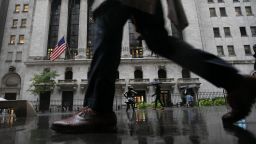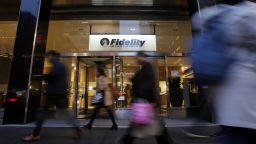Editor’s Note: This is an updated version of an article that ran on January 31, 2024.
The Federal Reserve’s benchmark interest rate remains at a 23-year high. That’s thanks to the central bank’s decision Wednesday to once again hold it steady, as it has done at the policy-making committee’s past five meetings.
That decision may be disappointing to some investors, homebuyers and those with a lot of credit card debt, since movement in the Fed’s overnight lending rate influences rates — directly or indirectly — on consumer financial products (e.g., credit cards, bank loans and mortgages).
But with the Fed signaling that no rate cuts are likely until summer, it also means anyone with savings still has at least a few more months to make hay of their stash.
That’s because you can still get inflation-beating interest rates that will grow any money you have set aside for emergencies, vacations, down payments or any other goal in your sights over the next several years.
However, that won’t happen if you just let it sit in a traditional checking or savings account that yields next to nothing. There are more lucrative, low-risk options out there, with rates that are still at or near their peaks. “But perhaps not for much longer,” said Ted Rossman, senior analyst at Bankrate. “If one of those fits into your financial plans, it’s best to act soon.”
So, consider the following options when deciding where to park your hard-earned savings.
High-yield online savings accounts
The average annual percentage yield on bank savings accounts was just 0.52% as of March 13, according to Bankrate. That average is kept low by the biggest brick-and-mortar banks like JPMorgan Chase and Bank of America, which still are offering a paltry 0.01%.
By contrast, there are still FDIC-insured online banks offering inflation-beating rates of between 4.35% and 5.35% on their high-yield savings accounts. Generally speaking, these are the best vehicles in which to keep your emergency funds for quick, easy access.
Choosing between an account that pays 0.52% and one that pays 5.35% can mean forfeiting hundreds of dollars in interest. “If you put $10,000 in a savings account, that’s a difference of $496 in interest earnings over the course of the year, assuming monthly compounding,” Rossman said.
While the rates on high-yield savings accounts have gone down a bit in recent months, “widespread cuts in online savings account rates are unlikely until the first Fed rate cut is near,” said Ken Tumin, founder of DepositAccounts.com.
As with any bank savings rate, high-yield savings account rates can change overnight, and the bank may not alert you when it lowers it. So make sure to check your monthly statement.
Certificates of deposits
Another high-return, low-risk investment that is great for money you likely won’t need to tap for a few months or even a couple of years is a certificate of deposit.
You can get the best returns on CDs through a brokerage such as Schwab, E*Trade or Fidelity. That’s because you can comparison shop for CDs from any number of FDIC-insured banks and will not have to set up individual accounts with each institution.
As of March 13, the average rate on a one-year CD was 1.95%, but some banks are offering as much are 5.4%.
If you can get a one-year CD at, say, 5.4%, you will make $540 on a $10,000 investment.
To get the greatest benefit from a CD, you have to leave the money invested for a fixed period. You can always access your principal sooner if you need to, but there may be early withdrawal penalties.
As of March 20, CDs listed on Schwab.com with durations from three months up to three years were all yielding between 5.2% and 5.51%. CD rates on durations between four and 10 years ranged from 4.40% to 5.15%.
Say you invest $10,000 in a one-year CD with a 5.36% APY. At the end of that period, you’d get your principal back plus $536 in interest when the CD matures, according to Bankrate’s CD calculator. If you chose a two-year CD at 5.25%, you’d bank an extra $1,078, assuming compounding interest. The same investment in a five-year CD at 5.15% would earn $2,854.
“It makes sense to go long with CDs. To hedge your bets, include terms from one to five years. Starting a CD ladder will provide this mix,” Tumin said.
If you don’t go through a brokerage you may get a reasonable deal from your primary bank, Tumin said.
For example, he noted, Wells Fargo is still offering up to 5.01% on both 4-month and 7-month CDs. Or, at Bank of America, you can get up to 4.75% on a 7-month CD.
But Tumin cautions that with any big bank CD you should take your money out at the end of the term, otherwise your bank may automatically renew it and lock you in to a much lower-yielding CD.
Money market accounts and funds
If you don’t want to set up an online savings account at another bank, your own bank may offer you a money market deposit account that pays a higher yield than your regular checking or savings accounts.
Money market accounts may have higher minimum deposit requirements than a regular savings account, but they are more liquid than a fixed-term certificate of deposit or Treasury bill, meaning they give you access to your money more quickly while still potentially giving you some of the highest yields available, said Doug Ornstein, senior manager for integrated solutions at TIAA Wealth Management.
But don’t confuse money market accounts with money market mutual funds, which invest in short-term, low-risk debt instruments. As of March 19, they had an average 7-day yield of 5.14%, according to the Crane Money Fund Index, which tracks the top 100 taxable money market funds.
Unlike money market deposit accounts, money market mutual funds are not insured by the FDIC. But if you invest in a money market fund through a brokerage, your overall account is likely to be insured through the Securities Investor Protection Corp, which offers protection in the event your brokerage ever goes under.
Treasury bills and notes
Another option for money you can leave untouched anywhere from several months to a few years is to buy short-term Treasury bills and medium-term notes, which are backed by the full faith and credit of the United States.
Three- and six-month bills had yields of 5.39% and 5.33% respectively on March 20 before the Fed’s meeting ended, while nine-month and one-year bills were offering 5.19% and 5.08% respectively, according to rates posted on Schwab.com for a $25,000 investment. Rates on Treasury notes with durations from two years to 10 years ranged between 4.29% and 4.72%.
If you’re someone who manages your portfolio like a hawk, you may feel comfortable buying T-bills on your own from TreasuryDirect.gov. But if you don’t, it might be easier just to buy new issues through your brokerage account or invest in a short-term bond index fund or ETF, said Andy Smith, executive director of financial planning at Edelman Financial Engines.
And if you’re looking at money that will be needed in three to five years, you might consider a diversified fund of highly rated government and corporate bonds, Ornstein said. An 18-month AAA-rated corporate bond, for instance, was yielding 4.82% this week, while the three-year was at 4.49%. Meanwhile, three-year AAA-rated municipal bonds (which are issued by local governments) had a rate of 3.98%, according to Schwab.com.
Don’t chase yield
When deciding on the best accounts and investments for your specific goals and peace of mind, it may pay to consult a fee-only fiduciary adviser — meaning, someone who doesn’t get paid a commission to sell you a particular investment.
What you’ll always want to do is build in flexibility for yourself so you can easily access cash, regardless of your timeline for key goals. “What happens if something changes and you need that down payment a lot sooner — or your parents need medical care fast?” Smith said.
That means balancing your desire for great yield with a need and desire for ease of access without penalty. Translation: Don’t chase yield for yield’s sake.
Think of it this way, Ornstein said: Unless you have huge sums to invest or are an institutional investor, the difference between getting a 5.1% yield versus 5% is negligible, and in fact it could even cost you more if there are penalties for taking your money out early. “Most of the time convenience is really important. Give up the 0.1%,” he advised.














